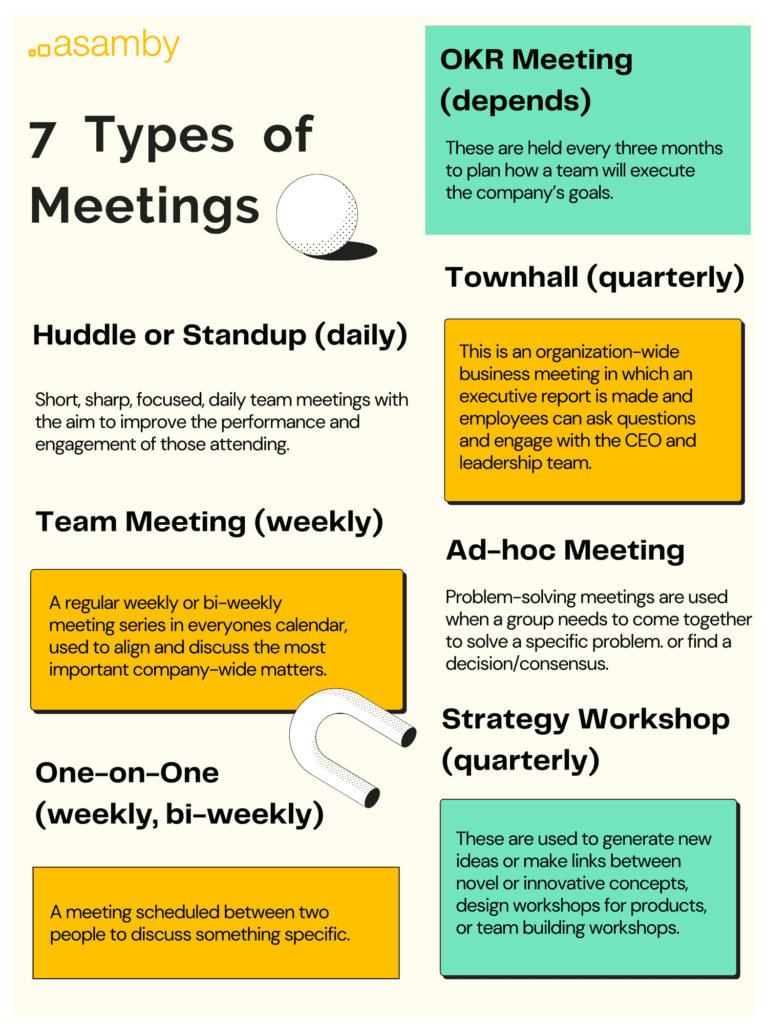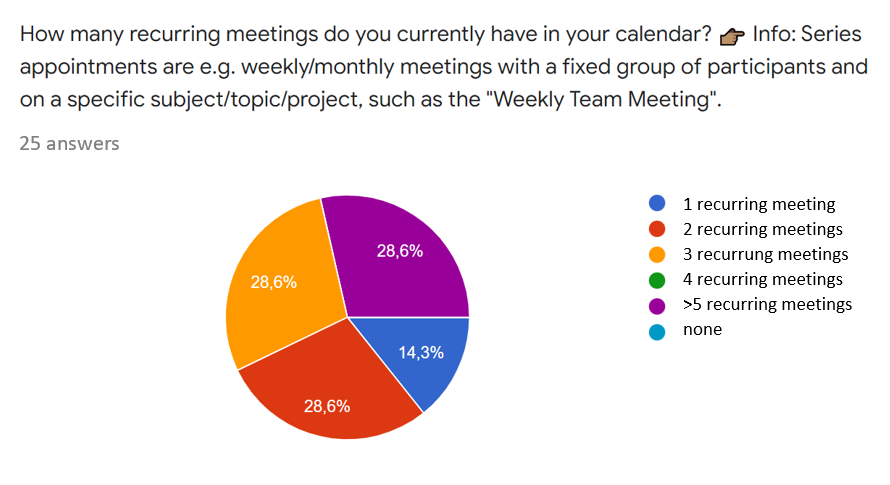
Reform your team’s meeting habits to boost productivity and business impact as a CEO (a post-pandemic approach).
If you work at a small business or growing company, you’ll eventually face the problem of too many meetings. This is an increasingly common scenario since the pandemic (more on it later).
Too many meetings will slowly weaken productivity by splintering everyone’s work into small chunks and reducing their time for deep work.
A scenario like this leaves people feeling their time is being wasted in meetings, which makes them disengaged. Once fun and collaborative workplace cultures can easily become a drag of meetings.
We will take a look into the underlying factors in an organization and discover solutions from there. This helps any leader to start a meeting reformation with intentional interventions that will shake off old meeting habits and boost productivity.
Tracing it back
Through conversations with fellow consultants, colleagues, clients, and friends one trend has become protruding in many work agendas and is dominating calendars worldwide. Since 2020, due to working primarily remotely, people developed a tendency to compensate for less office presence with more digital meetings.
DEEP WORK
As a result, meetings have become an instrument for feeling in control and for keeping in touch. The new normal in many teams is a 5-6 h meeting marathon on 2-3 days of the week. This resulted in a crippled residue of productive time and dramatically shortened opportunities for deep work.
By deep work, we mean the term coined by Cal Newport, as per his definition deep work refers to:
“Professional activity performed in a state of distraction-free concentration that push your cognitive capabilities to their limit. These efforts create new value, improve your skill, and are hard to replicate.”(Newport, 2016, Deep Work: Rules for Focused Success in a Distracted World)
This leaves employees with little control over their workdays – which reduces productivity even further. And with less productivity comes less impact and/or innovation. In conclusion, employees have limited authority over how they spend their time, and their work hours slip away towards low-impact and less productive activities.
There seems to be a growing need for a meeting-work balance.
WORKLAB
It seems this Covid legacy remains with teams around the world after two years, although the pandemic is phasing out. Over at WorkLab (a Microsoft-powered news hub for new work) scientists, engineers, and business leaders unravel the facts, trends, and new narratives changing the work environment.
They provide evidence that is backed up by science, which we often only feel and observe. Their work trend index tracked the increasing number of documents, chats, emails, and meetings from February 2020 (pre-Covid) to February 2021.
It is notable that, whilst all the items observed are increasing, the number of meetings does stick out.
For one particular reason: it involves the most human resources, requires preparation and a follow-up, the latter drawing in even more resources. This is surely ringing alarm bells for CEOs, Business Managers, and Operations Managers.

Taking a step back
Let’s take a step back and digest this. Too many meetings have brought productivity to a bare minimum? This is having a profound impact on the output of the job that is done between all these meetings.
But can we revert back? Or would this take away the lifeline of social interaction amongst the (remote) workforce?
As remote operations experts, we scale and supercharge operations and provide tailored initiatives after we analyzed the status quo. We work mainly with remote only or hybrid businesses. In early 2022, we conducted retrospectives for past client work (as you do in an agile team), and we’ve also found this pattern.
Not all meetings are bad
As we discussed in our post on the media-richness theory, having meetings is not per se a bad thing. But they need to be intentional, planned, prepared, and well-facilitated in advance in order to make them as efficient as possible. Only then, more space for deep work can be created.
PLANNED MEETINGS
It should be favored to have planned meetings over ad-hoc ones, as these are excessive meetings (with the highest media richness). If ad-hoc meetings are running high, it is an underlying problem that suggests looking at your organizational structure and culture.
From all the initiatives we designed, meeting structures and introducing impactful standard agenda items are a staple. Other meeting formats often become redundant or merge for greater efficiency. It shows immediate benefits while freeing up resources.
THE 6-STEP APPROACH
We wanted to offer a simple 6-step approach to all Business Managers, CEOs, and COS who want to have a happy and productive hybrid team that drives impact. Basically, a team that flows. Every week. Every day.
In this approach, we cluster all meetings into these seven categories (see graphic 1). These clusters can of course be altered to fit your organization’s needs.

Discovering how collective meeting habits take shape may be helpful in dismantling or replacing them. Our behavior in life helps us get our needs met more efficiently in our everyday lives. Over time, habits become deeply embedded in our brains.
We tend to stick to habits even though they start creating problems more than solving them. Hence, the collective habit of overburdening the workforce with ever-increasing meetings can be difficult to break.
BEHAVIORAL DESIGN
The field of Behavioral Science has some clues to help individuals and groups unlearn old habits and learn new ones. Behavioral Design (Behavioral Design) is a systematic understanding of how people think and make decisions. This understanding forms the basis of thinking about interventions that lead to behavioral change.
We have infused this 6-step method with insights from the behavioral design framework, although much simplified (see graphic 2). You may find it helpful to look at the meeting structure of your organization as a product and the team as a user.

Understand the user(s) and their ecosystem
Gather information on the current meeting patterns a short survey is sent to the team to retrieve comparable data (see graphic 3). Possible survey items are:

Frequency of one-on-ones, ad-hoc and recurring meetings and with whom (perhaps incl. free text field for main topics)
- Do meetings have an agenda, a moderator, is the outcome documented (action points, owners, deadlines, definition of done)?
- Ask for aspects the team member experiences when having meetings: meaningful social interaction, information flow, stress in-meeting, stress post-meeting, pressure to prepare, pressure to perform, anxiety for task overload, change-fatigue, refreshing, receive praise, align on topic, effective discussion, get feedback, critique, finding consensus, team spirit, etc.
- Rating of the current meeting hours/week is too low, right, or too high.
- Ask which tasks or duties get most neglected in favor for meeting attendance?
- Ask for effects on the daily duties, sprint or project outcome etc.?
- How can the effective meeting culture be optimized?
To check for tendencies and behavioral patterns, the survey may be rounded-up with example agendas or (if available) recordings. (It is advisable to inform participants before using the recordings).
After analyzing and summarizing the survey results, you might have a list like this:
General perceptions of meeting culture are, that attending many meetings:
Equals employee engagement,
- Assures a constant flow of information,
- Offer (rare) opportunities for social interaction with colleagues,
- Provide an option for small talk before and after,
- Allow seeing colleagues, and
- Help develop a team feeling.
UNCOVER THE BEHAVIORAL MODEL (ASSUMPTIONS BEHIND THE OBSERVABLE BEHAVIOR)
Observable behaviors, in our meeting context, are actions performed by a person that can be seen and measured. An example of an observable behavior would be a person switching off the video (camera) in a remote meeting. Also, the overall tendency to hold ad hoc meetings or to be very unstructured in meetings (lots of unstructured conversation, no outcomes) is observable behavior.
For the things you observe, ask yourself: What is the underlying assumption of your team that leads to these behaviors? What are underlying patterns that support behaviors that are not desirable and prevent other behavior that is desirable.
A few examples:
- Observation: Lots of unstructured discussion. Underlying assumption: Meetings in our organization have the main purpose of building relationships and/or the outcome of the meeting is less important than grooming the relationship.
- Many ad hoc meetings: It’s expected to resolve issues right away and face-to-face
- Many meetings overall: The more meetings I attend, the higher my perceived value for and by the company
- Lack of contribution: My opinion doesn’t matter
- Meetings with executives/the CEO are in high demand: More meetings with executives make contributors feel seen and appreciated.
- Etc.
💡 Summarize everything: Create a meeting ecosystem mind map (we recommend Miro) for the following areas: types of meetings, survey results, improvement ideas from team/leadership/CEO, observed behavior, etc.
Draw conclusions from all behaviors that you observe, both positive and negative. Next, you need to develop a strategy for tackling the undesired behaviors.
Strategies
Now that you have a good understanding of the users, the ecosystem, and their underlying assumptions, it’s time to consider the strategies. What can you do to modify undesired behavior or reward desired behavior?
In this context, a strategy could look like this:
- We want to limit time spent in meetings to max. 5 hours per week
- We want to rely more on asynchronous communication instead
- We want to replace meetings on topic X with a Slack channel
- We need the highest accountability for meetings and a drive for results and resolution in the meetings
- We want to bundle items that don’t need immediate attention to structured and scheduled meetings like 1:1s and team meetings. What doesn’t have to be discussed in a meeting shouldn’t be discussed in a meeting.
Choosing the strategy depends on your organization, your current situation regarding meeting times, and the goals you’re trying to achieve. Focus on the “what” in the strategy. What is it, that you’re deciding to reach? What is the desired new behavior?
Next up, we design the intervention that deals with the “How”. How do we execute the strategy?
Design the right intervention
For the above strategies, here are a few examples of what an intervention (i.e. measure) could look like.
1. LIMIT TIME SPENT IN MEETINGS
- Timeboxing: Each agenda item has a relevant time allocated and is displayed. In addition, a timer is used during the meeting to keep presentations and verbal contributions sharp and on point. Many tools offer these, e.g. Zoom and Miro.
- The organization-wide meeting time default is being changed from 60 to 45 minutes and from 30 to 20 minutes. You can do that in most calendar tools like Google Calendar or Outlook. This way, any meeting that’s just being scheduled without deliberately having a specific length will be shorter. According to Parkinson’s law, the job will still get done. Give it a try.
- In-person meetings are being held standing, which naturally decreases the duration.
2. INCREASE THE USE OF ASYNCHRONOUS COMMUNICATION
- Introduce channels in your chat tool for topics that often require ad-hoc meetings
- Design reports that can be easily sent and shared asynchronously and replace meetings where data is exchanged.
- Show it, say it, send it: introduce a video messaging tool (we use loom) to record e.g. a draft roadmap walkthrough that is due for approval
- Allow for time to resolve issues when not time-critical (defining escalation levels helps)
- As a leader, you should champion and encourage the behavior you want to see in others.
3. ACCOUNTABILITY AND RESULTS
- All meetings have an agenda (timeboxed), that states the desired outcome of the meeting. All recurring meetings follow a standardized structure (e.g. by creating templates in Miro).
- Everyone is aware of what they need to prepare for the meeting.
- There are clearly defined roles in recurring meetings for moderation, note-taking, and so on. Set revolving roles, so that responsibilities shift from time to time. This will increase ownership.
- Have clear meeting rules. (E.g., a limit of speaking time or a way to reach a decision/consensus when the discussion is not in agreement)
- Develop a good-enough mentality: Instead of examining the last exception, move on when you’ve found a working 80% solution
- No meeting without meeting minutes. Store the minutes in a central space, assign responsibilities, including deadlines, and set up a follow-up workflow for all tasks generated in a meeting.
- Publish and share results! Ensure that case-specific results can be used by other people, thus avoiding duplicate tasks or future meetings. Document solutions to problems that might occur again, so you don’t have to have another meeting to resolve them.
4. USE PLANNED MEETINGS AND ONLY DISCUSS WHAT’S NECESSARY
- Build a place for everyone to collect topics they need to discuss, so they can have them ready for the next planned meeting. (E.g., Miro, jam board, Qatalog, Asana, Notion)
- Don’t hold ad-hoc meetings yourself for things that can wait (or use Slack, loom & Co.)
- As your team’s task-related maturity increases, you can increase their decision-making freedom. This way it reduces the number of questions that need to be discussed in meetings. It can be helpful to have an escalation level and a clear decision-making framework.
Supporting tools/mechanisms for the intervention
In the next step, you need to implement the tools that will make the desired behavior easy. A few examples from the interventions above:
- Build channels in your chat tool
- Have a good chat tool
- Build standard meeting agendas and a standard way of writing notes (templates)
- Build shared agendas for your recurring meetings that everyone can contribute to
- Write down your meeting best practices including roles, and revisit it every once in a while
- Have an escalation level and decision-making framework
- Launch a no-meeting-Wednesday
We recommend having brainstorming sessions with the team to co-create solutions or iterate them after the first test cycle.
Test, evaluate, and iterate your intervention
Apropos test cycle. As for every change, after the implementation comes the evaluation. Did the interventions lead to the desired behavior changes and support strategy? If yes, what can you do to stabilize the success? If not, what can you do to change that?
We finally want to stress that meetings per se are a central tool for each organization. Without meetings, there could be no relationship, no alignment, and hardly any complex problem-solving.
Especially for remote teams.
However, it’s critical to be intentional about your meeting design and frequency. Manage it like every other activity your team engages in. After all, it comes down to the ROI:
Do the results that I get out of a meeting exceed the cost of that meeting, i.e. labor cost AND opportunity cost? As long as you can answer this question with yes, a meeting is a great thing to have.
Feel free to reach out if you want to know more about how to reform your team’s meeting habits.

